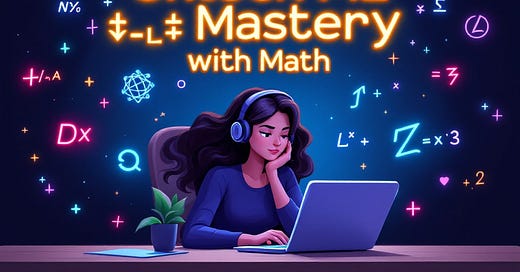The Missing Math Foundations You Need to Master Machine Learning
Machine learning can feel like a black box—code goes in, predictions come out, and the ‘how’ gets lost in translation. I’ve been there. But here’s the secret: it all comes back to math. Not the scary, complicated kind—the kind that makes machine learning finally make sense. Let’s break it down together.
Why Beginners Struggle with Machine Learning
When I first started exploring machine learning, I felt overwhelmed by the sheer volume of tutorials, libraries, and jargon. It was like being thrown into the deep end without knowing how to swim. Everyone seemed to focus on building models, tweaking hyperparameters, and getting results—but no one talked about the foundation.
The truth? It all comes back to math.
But not in the intimidating, classroom sense. This is about understanding just enough to make sense of how machine learning works, why it works, and how you can make it work for you.
The Real Reason Most Beginners Quit
Let’s face it: machine learning is marketed as this magical tool where you feed data into a model, and voilà—you have predictions. But when things don’t work (and they often don’t), you’re left guessing.
Without a strong foundation in math, debugging feels like fumbling in the dark. You might copy code, tweak a few parameters, and hope for the best, but you won’t truly understand why things fail—or how to fix them.
I’ve been there, and I know how frustrating it is. That’s why I decided to approach ML differently.
How Math Unlocks Machine Learning Mastery
Instead of rushing into building models, I took a step back and focused on the basics: linear algebra, calculus, and probability. Suddenly, concepts like gradient descent, loss functions, and feature transformations started making sense.
I realized that math isn’t just a prerequisite for machine learning—it’s the language that explains every decision a model makes.
Here’s what I learned:
Linear Algebra helps you understand how data is structured and manipulated. It’s the backbone of transformations, optimizations, and dimensionality reduction.
Calculus is the key to optimization. It explains how models learn by minimizing error.
Probability and Statistics teach you to measure uncertainty, interpret results, and make data-driven decisions.
These aren’t abstract theories—they’re practical tools that make machine learning approachable and effective.
Your Roadmap to Mastering Math for Machine Learning
If you’re just starting out, don’t worry about mastering everything at once. Here’s a simple roadmap that helped me build my foundation:
Linear Algebra: Start with vectors and matrices. Practice operations like multiplication, dot products, and decompositions. Tools like NumPy make it easy to experiment.
Calculus: Focus on derivatives and gradients. Understand how they relate to optimization and model training.
Probability and Statistics: Learn about distributions, Bayes’ theorem, and variance. These concepts will guide you in interpreting data and results.
This roadmap isn’t about perfection—it’s about progress. Even small steps can make a huge difference in how you approach machine learning.
A Little Gift to Get You Started
To make things easier, I’ve created a Machine Learning Roadmap for Beginners. It’s a simple, actionable guide that breaks down the math essentials and connects them to real-world ML problems.
You can download it here and start building your foundation today:
[Download the ML Roadmap]
Building Together, One Step at a Time
Writing this post reminded me of why I started sharing my journey in the first place. It’s not about being an expert or having all the answers—it’s about learning, growing, and building together.
That’s why I post every two days: to share what I’ve learned, what I’m struggling with, and how I’m navigating this space. If you’re on this journey too, I’d love to have you join me.
Machine learning isn’t just for the pros or the math geniuses—it’s for anyone willing to learn. With the right foundation, you can move from feeling stuck to building models that actually work.
Let’s make it happen.



